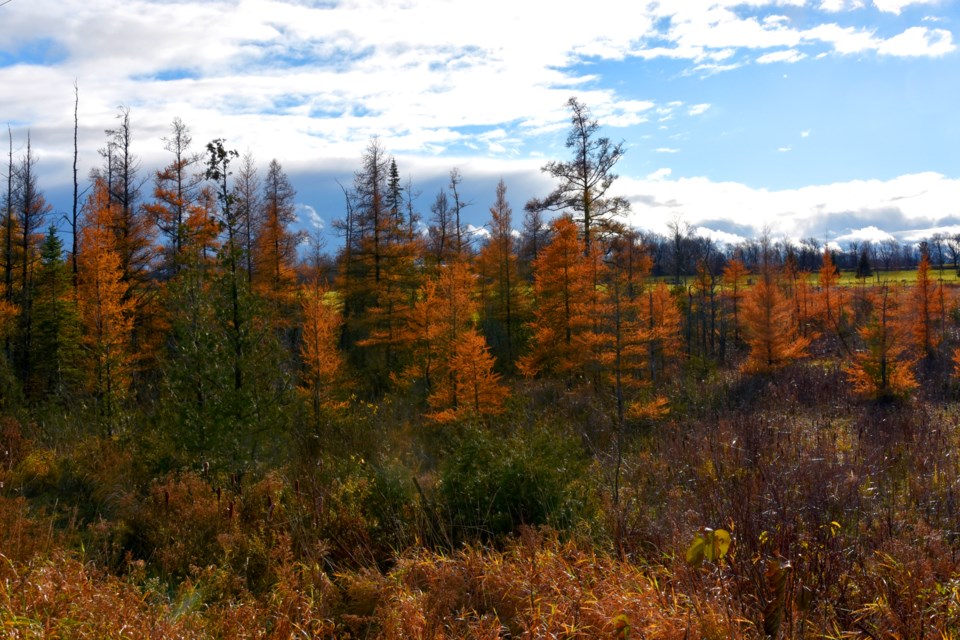Well, that last wind storm certainly did it, effectively removing all the hardwood leaves from our woodlots. Now that the leaves are down and their use as a tourist attraction is no more, they are mulched, raked, burned or ignored. Ahh, fame and glory, so fleeting.
A few weekends ago, a walk through a hardwood forest that was dressed in its autumnal best was to be savoured. But take that same route now, when leaves are soggy and underfoot, and the mood of the outing becomes rather sombre. Those missing hues of colour really make a difference.
However, there is no need for despair just yet. One tree species that is still performing well is the tamarack! Take a wander by some of our local wetlands and you'll find a wonderful golden hue to the landscape. While this tree is rather quiescent in behaviour, their brilliant yellow needles glow radiantly when bathed in a bit of afternoon sunshine.
Tamarack is a bit of an oddball in the world of evergreens, as they aren't always 'ever' green. Spring and summer certainly finds them with a cloak of soft green needles, yet, like hardwood trees, it drops its leaves in the fall. But it has a good enough reason for doing so.
Tamarack like to grow in very wet soils. As it has a ready supply of moisture, it does not have to produce the waxy coating on its needles like other conifers. That thick coating allows white pine and others to survive near drought conditions, especially during the frozen months, by severely limiting the amount of water lost during transpiration; the longer a pine can keep its needles, the less amount of precious water is lost.
As tamarack have their roots soaking in moisture, even below the snow, they can drop their needles and still find enough water to keep them going. And, ta-da, we are treated to a golden display as the no-longer-needed needles are shut down.
While not always mentioned in the fall colour tour pamphlets, tamarack, also known as larch, has been around for quite some time. From about 350 years ago there is a written record that tamarack is a useful wood for building, in particular for snowshoes. Another name for tamarack is hackmatack, which is said to be derived from the Native word "akemantak." which means "wood for snowshoes."
Another early record, this time from 1672, notes that "a desperate bruise was cured by an unguent made with leaves of a larch tree and hog's grease, but larch gum is best." Hmm ... a desperate bruise indeed.
Other uses of the gum and bark include easing indigestion and acting as a laxative. More traditional uses of the wood include handles for tools and parts of ship building. Even the strong rootlets have a history, as they were used to sew the bark onto ancient canoes.
From the mid-1800s to mid-1900s tamarack bark was used for tanning leather. Many of the tamarack trees in north Simcoe County were used for posts and crate material, while the bark was sent by rail cars to the tannery located in Huntsville.
While tamarack seem well suited to a wet environment, they enjoy lots of sunshine, which is why you will find them along the open edge of an acidic swamp or bog. Once the competing and shade tolerant balsam fir trees get started, the young larch don't stand a chance.
Tamaracks grow quite slowly, and as a result their wood is very strong. But because of this slow growth rate, it is difficult to find a big tree. A tree that is a just few centimetres in diameter may indeed be several decades old in growth. A good seed producing tree needs to be between 50 and 150 years old, but once in the reproductive age it produces cones every year (peak production years are on a 3-5 year cycle).
The cones form early in the year, appearing first like rose petals but quickly drying to a crispy brown as the seeds are formed.
Larch ... hackmatack .... tamarack, call 'em what you will, are not found commonly in our region. They are in patches here and there, but most always near water – check out the low lying areas in both town and country. So when the leaves are down and your spirits need a lift, go find a hackmatack!
